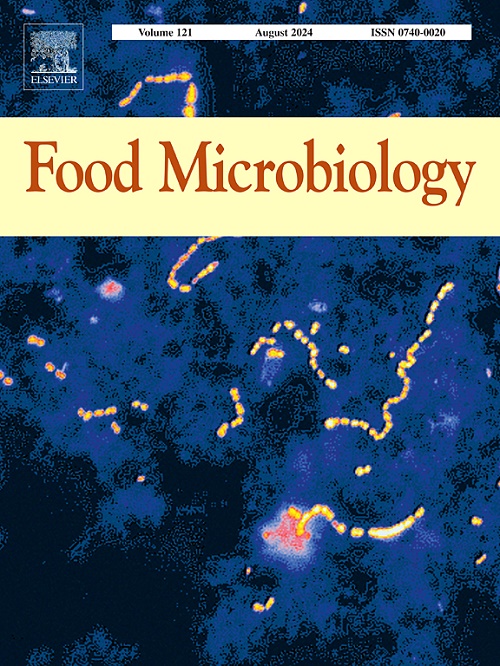Comprehensive phenotyping combined with multi-omics of Salmonella Infantis and its H2S negative variant - Resolving adaption mechanisms to environmental changes
IF 4.5
1区 农林科学
Q1 BIOTECHNOLOGY & APPLIED MICROBIOLOGY
引用次数: 0
Abstract
The zoonotic pathogen S. Infantis is of emerging importance, making detection in poultry critical. Phenotypic changes, which are significant for standardized control programs via EN/ISO 6579–1:2017, could lead to pathogens remaining undetected, increasing the risk of food-borne outbreaks. This study investigates an S. Infantis strain with both normal growth (NCP) and atypical H₂S-negative colony variant (ACV) from an Austrian broiler farm. NCP and ACV underwent comprehensive analyses, including stability tests, electron microscopy, whole-genome sequencing, transcriptomics, and proteomics. Our findings demonstrate a stable atypical colony variant exhibiting acquired resistance against cefoxitin in ACV. Genomic analysis identified 9 single nucleotide polymorphisms (SNPs) and two deletions, affecting genes involved in porphyrin and sulfur metabolism. Key factors were a mutation disrupting cysG, which is essential for siroheme biosynthesis and a vital cofactor in sulfur metabolism, and a stop codon in menD (2-oxoglutarate decarboxylase), crucial for small colony variant appearance. Consequently, we hypothesize that these mutations lead to a deficiency in siroheme, as well as anaerobic sulfur respiration altogether resulting in the H₂S-negative phenotype. Functional network analysis highlighted compensatory upregulation of alternative metabolic pathways, including nitrate metabolism, propanoate metabolism and mixed-acid fermentation, which may aid ACV's persistence and adaptation under anaerobic conditions. Reduced flagellin expression suggests a mechanism for immune evasion. These genetic and metabolic adaptations likely respond to environmental stressors, such as oxidative stress from disinfectants or antimicrobial pressure, leading to the emergence of the H₂S-negative phenotype. Consequently, this study provides insights into the genetic and biochemical adaptations of an atypical S. Infantis variant.
婴儿沙门氏菌及其H2S阴性变异的多组学综合表型分析——解决环境变化的适应机制
人畜共患病原体婴儿S.是新兴的重要性,使检测家禽至关重要。表型变化对于通过EN/ISO 6579-1:2017的标准化控制计划具有重要意义,可能导致病原体未被发现,从而增加食源性暴发的风险。本研究调查了来自奥地利肉鸡养殖场的一株具有正常生长(NCP)和非典型H₂s阴性菌落变异(ACV)的婴儿链球菌菌株。对NCP和ACV进行了全面的分析,包括稳定性测试、电子显微镜、全基因组测序、转录组学和蛋白质组学。我们的研究结果表明,在ACV中,一种稳定的非典型菌落变异表现出对头孢西丁的获得性耐药性。基因组分析鉴定出9个单核苷酸多态性(snp)和2个缺失,影响卟啉和硫代谢相关基因。关键因素是一个突变破坏了cysG,这是siroheme生物合成所必需的,也是硫代谢的重要辅助因子,以及一个终止密码子(2-氧葡萄糖酸脱羧酶),这对小菌落变异的出现至关重要。因此,我们假设这些突变导致siro血红素缺乏,以及厌氧硫呼吸,从而导致H₂s阴性表型。功能网络分析强调了代偿性上调替代代谢途径,包括硝酸盐代谢、丙酸代谢和混合酸发酵,这可能有助于ACV在厌氧条件下的持久性和适应性。鞭毛蛋白表达减少提示免疫逃避机制。这些遗传和代谢适应可能对环境应激因子作出反应,例如消毒剂或抗菌压力引起的氧化应激,导致H₂s阴性表型的出现。因此,这项研究提供了非典型S.婴儿变异的遗传和生化适应的见解。
本文章由计算机程序翻译,如有差异,请以英文原文为准。
求助全文
约1分钟内获得全文
求助全文
来源期刊

Food microbiology
工程技术-生物工程与应用微生物
CiteScore
11.30
自引率
3.80%
发文量
179
审稿时长
44 days
期刊介绍:
Food Microbiology publishes original research articles, short communications, review papers, letters, news items and book reviews dealing with all aspects of the microbiology of foods. The editors aim to publish manuscripts of the highest quality which are both relevant and applicable to the broad field covered by the journal. Studies must be novel, have a clear connection to food microbiology, and be of general interest to the international community of food microbiologists. The editors make every effort to ensure rapid and fair reviews, resulting in timely publication of accepted manuscripts.
 求助内容:
求助内容: 应助结果提醒方式:
应助结果提醒方式:


